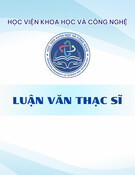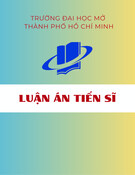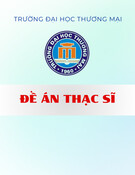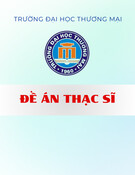
1
MINISTRY OF EDUCATION AND TRAINING
THAI NGUYEN UNIVERSITY
XUYEN THI LUU
STUDY ON THE GROWTH AND DEVELOPMENT
ABILITY OF SOME IMPORTED SOYBEAN
VARIETIES AND CULTIVATION TECHNIQUES FOR
PROSPECT VARIETY IN THAI NGUYEN
Major: AGRONOMY
Code: 62 62 01 01
DISSERTATION FOR DOCTOR OF PHYLOSOPHY
IN AGRICULTURE
THAI NGUYEN - 2011

3
RELATED PUBLICATIONS
1. Xuyen Thi Luu, Dep Thi Luan, Tam Minh Hoang (2008), “Effect of
planting season of soybean variety 99084 - A28 in Spring and Winter Crop
in Thai Nguyen”, Journal of Science and Technology, 3(47) - Vol. 2/2008,
Thai Nguyen University Press , pp: 29 - 32.
2. Xuyen Thi Luu, Dep Thi Luan, Tam Minh Hoang (2010), “Study on the
effect of planting densities on the growth and development of soybean
varieties 99084 - A28 in winter crops 2007 - 2008 in Thai Nguyen”, Journal
of Agriculture and rural development, October, 2010, Press of Sciences and
technology, 18 Hoang Quoc Viet, Hanoi; pp: 126 - 130.

1
INTRODUCTION
1. Background
Soybean (Glycine max (L) Merr) is industrial and short growing - duration crop that
is multi-purpose plant with high economic value. Its products supply food for human
and livestocks; they are also materials for processing industry and high valueable for
exporting. Besides, soybean plants are short growing-time crops that are very suitable
for crop rotation, intercroping, crop overlaping with many other plants and soil
improvement crop (Dan The Ngo et al., 1999) [10].
Soybean is popularly planted in all seven ecological areas over Vietnam.
Northern midland and mountainous region has the biggest area (69425 ha) which
holds 37.01% the total area of soybean in Vietnam but the lowest yield (1.03 tons/ha).
There are many reasons for low yield of soybean in this region such as unavailability
of high-yielding soybean varieties, low investment and unreasonable cultivation
methods. It is noted that lack of high-yielding soybean varieties and suitable
cultivation techniques are the main limitation to soybean yield. The result of variety
investigation in 2003-2004 of Department of Crop Production, Ministry of
Agriculture and Rural Development (2006) [9] showed that: The Northern Midland
and Mountainous Region is one of three areas planting high percentage of local
varieties of soybean and low percentage of new soybean varieties (37.5 - 38.4% areas
with local soybean varieties).
In recent years, Vietnam has imported many good varieties; however their
adaptability to ecological region is very different. For that reason we carried out the
research titled:” Study on the growth and development ability of some imported
soybean varieties and cultivation techniques for prospect variety in Thai Nguyen”.
2. Research Objectives
- Selecting the imported soybean varieties that have good growth and
development, are suitable with the ecological conditions of Thai Nguyen.
- Determining some intensive cultivation techniques that are suitable for the
prospect variety.

2
3. Scientific and reality significance
3.1. Scientific significance
The research intends to select imported soybean varieties and determining
suitable techniques for selected variety in Thai Nguyen. The research results laid the
pavement for developing some imported soybean varieties in Thai Nguyen.
The research selected prospect soybean variety from the testing imported
varieties, suitable for ecological environment in Thai Nguyen and determined the
technical methods suitable for selected variety in spring and winter in Thai Nguyen.
3.2. Reality significance
- The thesis found out the limitation and prospects for developing soybean
production in Thai Nguyen.
- Determining and providing some soybean varieties that have good growth and
development in spring and winter in Thai Nguyen.
- The study results from some technical methods for cultivating soybean contributed
on cultivation guideline improvement for soybean intensive farming in winter and
spring in Thai Nguyen.
- The using new and high yielding variety of soybean and new technical methods
resulted in higher economic efficiency, raising the incomes for farmers that planting
soybean and promoted the development of soybean production in Thai Nguyen.
4. New findings of the thesis
- Based on investigating, analyzing and assessing some advantages and disadvantages
effecting on production and results from research on selecting soybean varieties from
imported varieties and on determining some technical methods, the scientific basement
for developing soybean in winter and spring in Thai Nguyen was confirmed.
- Determined the growth and development ability of some soybean varieties in
spring and winter crop in Thai Nguyen and two high yielding varieties T2000 and
99084 - A28 were selected. In winter crops, the average yield were from 1.71 to 1.77
tons/ha that were higher than the control variety DT84 by 0.38 to 0.45 tons/ha. In
spring crops, the average yield were from 2.16 to 2.24 tons/ha that were higher than
the control by 0.37 to 0.45 tons/ha.

3
- Suggested some techniques for completing cultivation guideline for new soybean
variety (99084 - A28) with optimum planting time in spring crop is from 15th, February
to 6th, March and 5th to 25th, September in winter. The optimum density in spring was
35 plants/ha and 45 plants/ha in winter. The most suitable fertilizer combination was 5
tons of manure + 40 kg N + 80 kg P2O5 + 40 kg K2O + 300 kg of lime/ha.
- Trial of soybean planting in winter and spring in three places of Thai Nguyen
was successfully built and implemented. The trial locations are Trang Xa Commune -
Vo Nhai District, Hoa Thuong Commune - Dong Hy District and Son Cam
Commune - Phu Luong District with the variety 99084 - A28 and new technical
methods that got the yield from 2.54 to 2.83 tons/ha, raising by 52,8 - 53,9%
compared to the control in winter; 2.32 - 2.75 tons/ha raising by 52,6 - 63,5% than
the control; the interest were from 20.2 to 24.5 millions VND/ha in spring and 20.3 to
23.3 millions VND in winter.
5. Thesis structure
The dissertation was fulfilled with 102 pages, 31 tables, 3 figures and 2
diagrams. Beside the introduction, the dissertation was divided into 3 chapters where
chapter 1: Literature review (25 pages); chapter 2: Research content and methods (13
pages); chapter 3: Results and discussion (58 pages), Conclusion and suggestion (2
pages) and 55 pages for appendices. The dissertation used 115 references in Vietnamese
and 58 references in English.
CHAPTER 1: LITERATURE REVIEW
1.1. Soybean production status in Vietnam and in the world
1.1.1. Soybean production in the world
The data collection from Dan The Ngo et al., (1999) [10], Duc Van Hoang
(1982) [23], FAO Statistic Database, 2009 [75] showed that the soybean production
of the world has increased rapidly in area - yield and output. In the period of 1963 -
1964, the planting area of soybean over the world was 27.3 millions hectare and
increased to 96.87 hectare in 2008. In 1960 the yield of soybean over the world was





![Luận văn Thạc sĩ: Tổng hợp và đánh giá hoạt tính chống ung thư của hợp phần lai tetrahydro-beta-carboline và imidazo[1,5-a]pyridine](https://cdn.tailieu.vn/images/document/thumbnail/2025/20250816/vijiraiya/135x160/26811755333398.jpg)




















